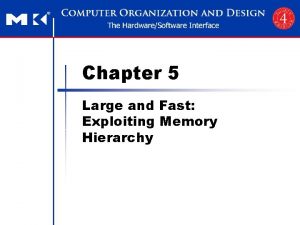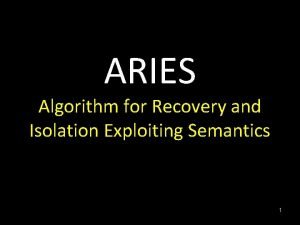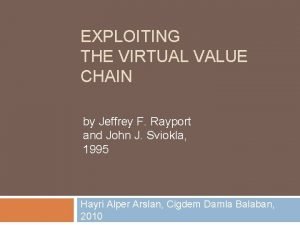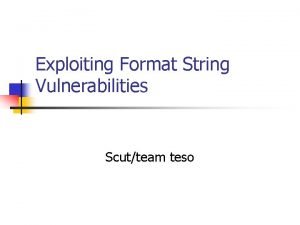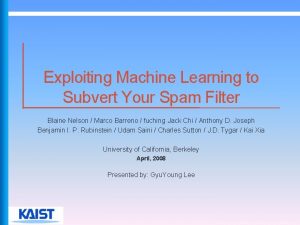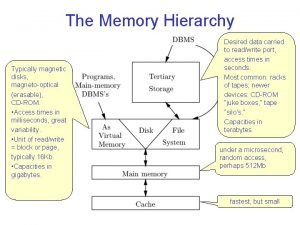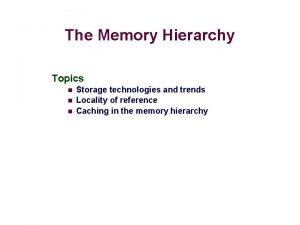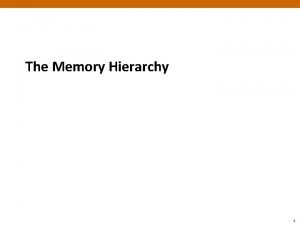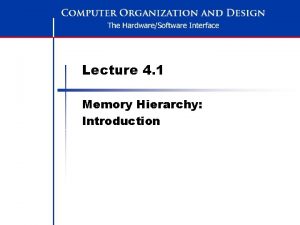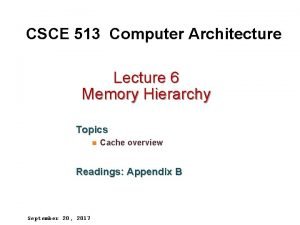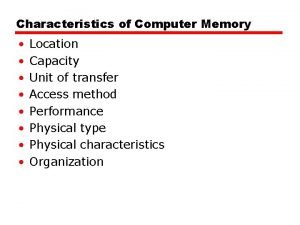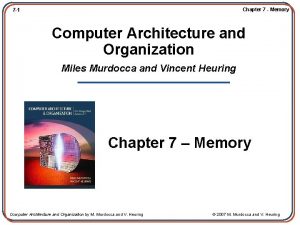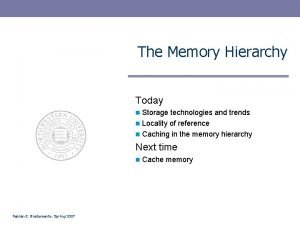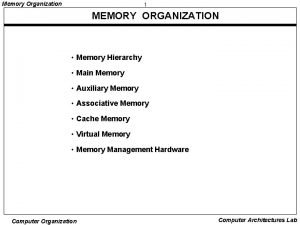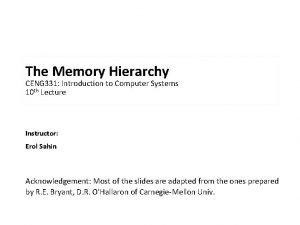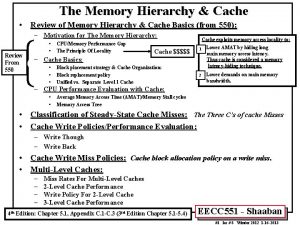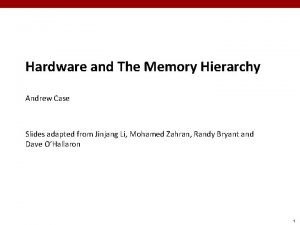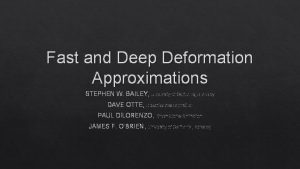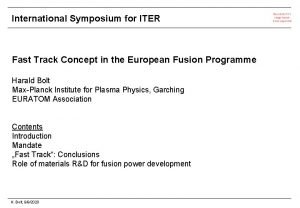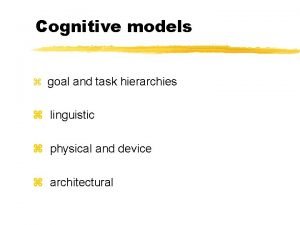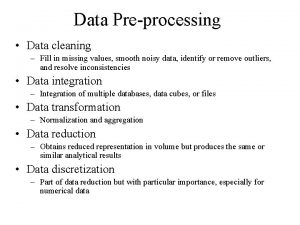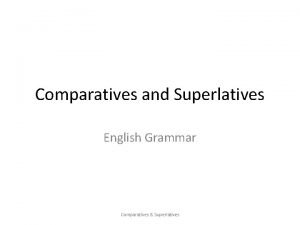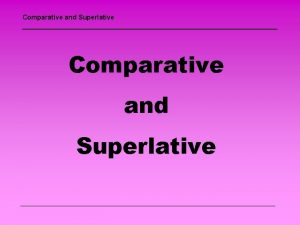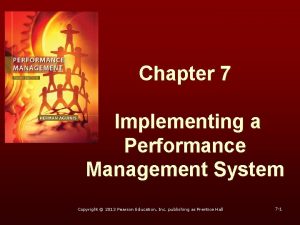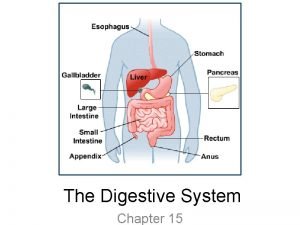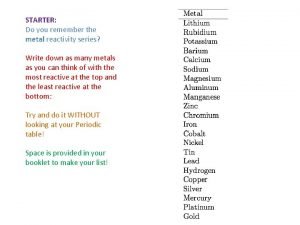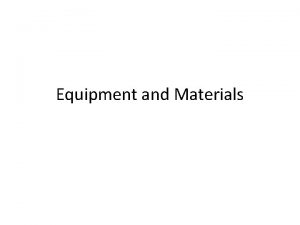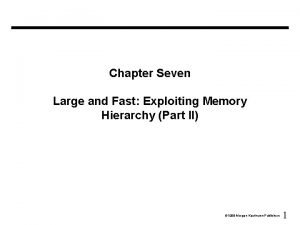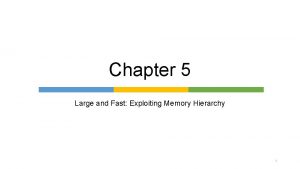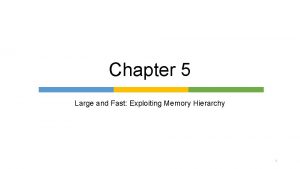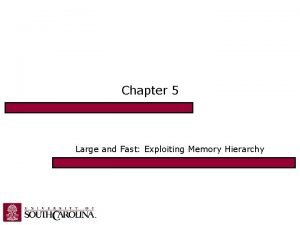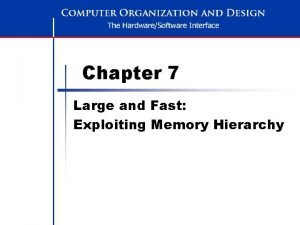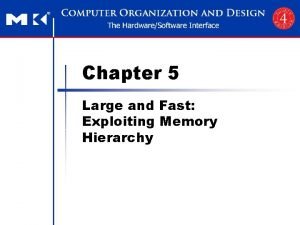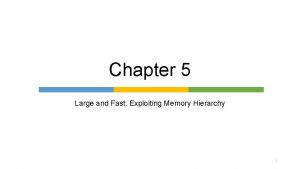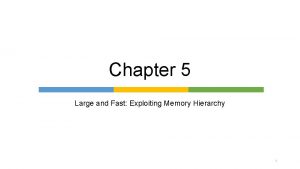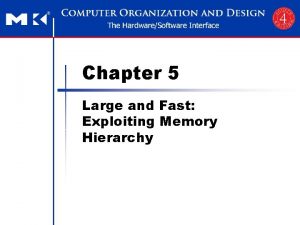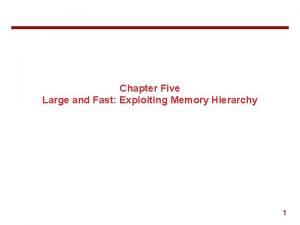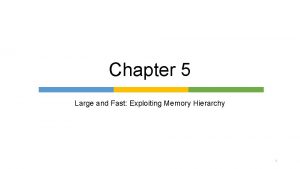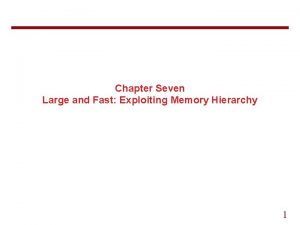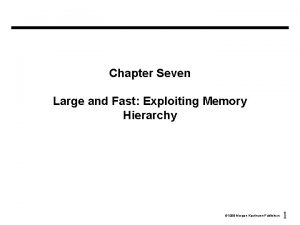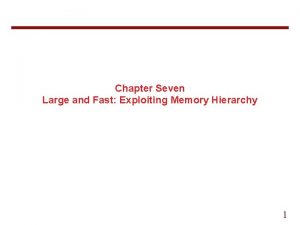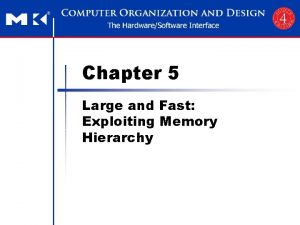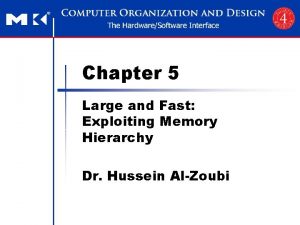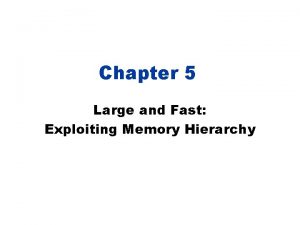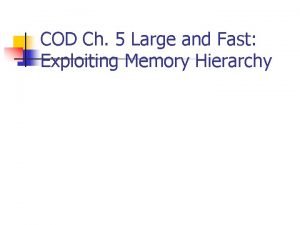Large and Fast Exploiting Memory Hierarchy Memory Technology






































































- Slides: 70

Large and Fast: Exploiting Memory Hierarchy

Memory Technology • Static RAM (SRAM) • 0. 5 ns – 2. 5 ns, $2000 – $5000 per GB • Dynamic RAM (DRAM) • 50 ns – 70 ns, $20 – $75 per GB • Magnetic disk • 5 ms – 20 ms, $0. 20 – $2 per GB • Ideal memory • Access time of SRAM • Capacity and cost/GB of disk

Principle of Locality • Programs access a small proportion of their address space at any time • Temporal locality • Items accessed recently are likely to be accessed again soon • e. g. , instructions in a loop, induction variables • Spatial locality • Items near those accessed recently are likely to be accessed soon • E. g. , sequential instruction access, array data

Taking Advantage of Locality • Memory hierarchy • Store everything on disk • Copy recently accessed (and nearby) items from disk to smaller DRAM memory • Main memory • Copy more recently accessed (and nearby) items from DRAM to smaller SRAM memory • Cache memory attached to CPU







Mapping Function Cache size = 64 KB 216 Bytes Cache block = 4 B 22 Bytes 1 word Number of lines = 214



b t b



1 2 3

0001 0110 0011100111 00 1 6 Line# = 0011100111 = 0 CE 7







1 2 3


XNOR = XOR


Next slide

00010110011100111 00 0 5 8 C E 7 Line# = 0011100111 = 0 CE 7

Set Associative Cache - hybrid between a fully associative cache & direct mapped cache. - considered a reasonable compromise between the complex hardware needed for fully associative caches (parallel searches of all slots), and the simplistic direct-mapped scheme, - may cause collisions of addresses to the same slot

Set Associative Cache - Parking lot analogy - 1000 parking spots (0 -999) – 3 digits needed to find slot - Instead use 2 digits (say last 2 digits of SSN) to hash into 100 sets of 10 spots. - Once you find your set, you can park in any of the 10 spots.

Finding a Set - There are 213 sets (also known as 8 K-way set associative cache) - Parallel search all 213 sets to see if 9 -bit tag matches a particular slot) - If found, go to matching set (b 14 – b 2) bits get word at b 1 – b 0, o. w. , decide which slot you want to put data in from memory.



1 2 3

Tag Data Set


Set#1 Set#0 Line# (14 bits) 9 bits Set#(13 bits) 2 bits 00010110011100111 00 0 2 C Line# = = set# (2 way - consider 1 out of 13 bits) 0011100111 0 CE 7










Measuring Cache Performance • Components of CPU time • Program execution cycles • Includes cache hit time • Memory stall cycles • Mainly from cache misses • With simplifying assumptions:

Cache Performance Example • Given • I-cache miss rate = 2% • D-cache miss rate = 4% • Miss penalty = 100 cycles • Base CPI (ideal cache) = 2 • Load & stores are 36% of instructions • Miss cycles per instruction • I-cache: 0. 02 × 100 = 2 • D-cache: 0. 36 × 0. 04 × 100 = 1. 44 • Actual CPI = 2 + 1. 44 = 5. 44 • Ideal CPU is 5. 44/2 =2. 72 times faster

Average Access Time • Hit time is also important for performance • Average memory access time (AMAT) • AMAT = Hit time + Miss rate × Miss penalty • Example • CPU with 1 ns clock, hit time = 1 cycle, • miss penalty = 20 cycles, • I-cache miss rate = 5% • AMAT = 1 + 0. 05 × 20 = 2 • 2 cycles per instruction

Multilevel Caches • Primary cache attached to CPU • Small, but fast • Level-2 cache services misses from primary cache • Larger, slower, but still faster than main memory • Main memory services L-2 cache misses • Some high-end systems include L-3 cache

Multilevel Cache Example • Given • CPU base CPI = 1, clock rate = 4 GHz • Miss rate/instruction = 2% • Main memory access time = 100 ns • With just primary cache • Miss penalty = 100 ns/0. 25 ns = 400 cycles • Effective CPI = 1 + 0. 02 × 400 = 9

Example (cont. ) • Now add L-2 cache • Access time = 5 ns • Global miss rate to main memory = 0. 5% • Primary miss with L-2 hit • Penalty = 5 ns/0. 25 ns = 20 cycles • Primary miss with L-2 miss • Extra penalty = 500 cycles

Example (cont. ) L 1 (miss) MEM = 0. 02(400) = 8 cycle penalty (100/. 25 = 400 for memory access) L 1 (miss) L 2(miss) MEM = 0. 02(400) = 8 cycle penalty (5/. 25 = 20 cycles for L 2 access) + (400 for memory access) L 1 miss: 0. 02 L 2 miss: 0. 005 Total L 1+L 2 miss = 0. 02(20) + 0. 005(400) = 2. 4 • CPI = 1 + 2. 4 = 3. 4 • Performance ratio = 9/3. 4 = 2. 6 (over L 1 only cache) Since effective CPI = 1 + 0. 02 × 400 = 9 for L 1 cache (see two slides prior to this one)

Multilevel Cache Considerations • Primary cache • Focus on minimal hit time • L-2 cache • Focus on low miss rate to avoid main memory access • Hit time has less overall impact • Results • L-1 cache usually smaller than a single cache • L-1 block size smaller than L-2 block size

Interactions with Advanced CPUs • Out-of-order CPUs can execute instructions during cache miss • Pending store stays in load/store unit • Dependent instructions wait in reservation stations • Independent instructions continue • Effect of miss depends on program data flow • Much harder to analyze • Use system simulation

Cache Control • Example cache characteristics • Direct-mapped, write-back, write allocate • Block size: 4 words (16 bytes) • Cache size: 16 KB (1024 blocks) • 32 -bit byte addresses • Valid bit and dirty bit per block • Blocking cache • CPU waits until access is complete 31 10 9 4 3 0 Tag Index Offset 18 bits 10 bits 4 bits

Interface Signals CPU Read/Write Valid Address 32 Write Data 32 Ready Cache Address 32 Write Data 128 Ready Multiple cycles per access Memory

Finite State Machines • Use an FSM to sequence control steps • Set of states, transition on each clock edge • State values are binary encoded • Current state stored in a register • Next state = fn (current state, current inputs) • Control output signals = fo (current state)

Cache Controller FSM Could partition into separate states to reduce clock cycle time

Cache Coherence Problem • Suppose two CPU cores share a physical address space • Write-through caches (all writes go through to memory) Time Event step CPU A’s cache CPU B’s cache 0 Memory 0 1 CPU A reads X 0 0 2 CPU B reads X 0 0 0 3 CPU A writes 1 to X 1 0 1

Coherence Defined • Informally: Reads return most recently written value • Formally: • P writes X; P reads X (no intervening writes) read returns written value • P 1 writes X; P 2 reads X (sufficiently later) read returns written value • i. e. , CPU B reading X after step 3 in example • P 1 writes X, P 2 writes X all processors see writes in the same order • End up with the same final value for X

Cache Coherence Protocols • Operations performed by caches in multiprocessors to ensure coherence • Migration of data to local caches • Reduces bandwidth for shared memory • Replication of read-shared data • Reduces contention for access • Snooping protocols • Each cache monitors bus reads/writes • Directory-based protocols • Caches and memory record sharing status of blocks in a directory

Invalidating Snooping Protocols • Cache gets exclusive access to a block when it is to be written • Broadcasts an invalidate message on the bus • Subsequent read in another cache misses • Owning cache supplies updated value CPU activity Bus activity CPU A’s cache CPU B’s cache Memory 0 CPU A reads X Cache miss for X 0 CPU B reads X Cache miss for X 0 CPU A writes 1 to X Invalidate for X 1 CPU B read X Cache miss for X 1 0 0 1 1

Memory Consistency • When are writes seen by other processors • “Seen” means a read returns the written value • Can’t be instantaneously • Assumptions • A write completes only when all processors have seen it • A processor does not reorder writes with other accesses • Consequence • P writes X then writes Y all processors that see new Y also see new X • Processors can reorder reads, but not writes

Intel Nehalem 4 -core processor (Corei 7) Core Shared L 3 Cache Per core: 32 KB L 1 I-cache, 32 KB L 1 D-cache, 512 KB L 2 cache § 5. 10 Real Stuff: The AMD Opteron X 4 and Intel Nehalem Multilevel On-Chip Caches

Core Shared L 3 Cache Core § 5. 10 Real Stuff: The AMD Opteron X 4 and Intel Nehalem Core

3 -Level Cache Organization Intel Nehalem AMD Opteron X 4 L 1 caches (per core) L 1 I-cache: 32 KB, 64 -byte blocks, 4 -way, approx LRU replacement, hit time n/a L 1 D-cache: 32 KB, 64 -byte blocks, 8 -way, approx LRU replacement, writeback/allocate, hit time n/a L 1 I-cache: 32 KB, 64 -byte blocks, 2 -way, LRU replacement, hit time 3 cycles L 1 D-cache: 32 KB, 64 -byte blocks, 2 -way, LRU replacement, writeback/allocate, hit time 9 cycles L 2 unified cache (per core) 256 KB, 64 -byte blocks, 8 -way, 512 KB, 64 -byte blocks, 16 -way, approx LRU replacement, write- approx LRU replacement, writeback/allocate, hit time n/a L 3 unified cache (shared) 8 MB, 64 -byte blocks, 16 -way, replacement n/a, writeback/allocate, hit time n/a: data not available 2 MB, 64 -byte blocks, 32 -way, replace block shared by fewest cores, write-back/allocate, hit time 32 cycles

Concluding Remarks • Fast memories are small, large memories are slow • We really want fast, large memories • Caching gives this illusion • Principle of locality • Programs use a small part of their memory space frequently • Memory hierarchy • L 1 cache L 2 cache … DRAM memory disk • Memory system design is critical for multiprocessors
 Large and fast: exploiting memory hierarchy
Large and fast: exploiting memory hierarchy Virtual memory in memory hierarchy consists of
Virtual memory in memory hierarchy consists of Example of acid-fast bacteria
Example of acid-fast bacteria Differentiate between acid fast and non acid fast bacteria
Differentiate between acid fast and non acid fast bacteria New entry exploitation
New entry exploitation Algorithms for recovery and isolation exploiting semantics
Algorithms for recovery and isolation exploiting semantics What is virtual value chain
What is virtual value chain Exploiting format string vulnerabilities
Exploiting format string vulnerabilities Spamato
Spamato Exploiting the sponsorship examples
Exploiting the sponsorship examples Maslow's hierarchy of needs technology
Maslow's hierarchy of needs technology Magnetic disk in memory hierarchy
Magnetic disk in memory hierarchy What is memory hierarchy
What is memory hierarchy Memory hierarchy diagram
Memory hierarchy diagram Memory hierarchy in os
Memory hierarchy in os Explain memory hierarchy
Explain memory hierarchy Memory hierarchy in computer architecture
Memory hierarchy in computer architecture Computer memory hierarchy
Computer memory hierarchy Computer memory hierarchy diagram
Computer memory hierarchy diagram Memory hierarchy definition
Memory hierarchy definition Computer memory hierarchy diagram
Computer memory hierarchy diagram Hit ratio in computer architecture
Hit ratio in computer architecture Hierarchy of trends
Hierarchy of trends Memory hierarchy pyramid
Memory hierarchy pyramid Memory hierarchy
Memory hierarchy Draw memory hierarchy
Draw memory hierarchy Memory hierarchy
Memory hierarchy Memory hierarchy
Memory hierarchy Memory hierarchy
Memory hierarchy Internal memory and external memory
Internal memory and external memory Primary memory and secondary memory
Primary memory and secondary memory Virtual memory
Virtual memory Emerging memory technologies
Emerging memory technologies Advances in memory technology
Advances in memory technology Semantics prototype
Semantics prototype Implicit memory
Implicit memory Long term memory vs short term memory
Long term memory vs short term memory Logical memory is broken into
Logical memory is broken into Which memory is the actual working memory?
Which memory is the actual working memory? Eidetic memory vs iconic memory
Eidetic memory vs iconic memory Symmetric shared memory architecture
Symmetric shared memory architecture Causes of cold war
Causes of cold war Qemu, a fast and portable dynamic translator
Qemu, a fast and portable dynamic translator Fast exact and approximate geodesics on meshes
Fast exact and approximate geodesics on meshes Fast and deep deformation approximations
Fast and deep deformation approximations Crash course muscles part 2
Crash course muscles part 2 Fast random walk with restart and its applications
Fast random walk with restart and its applications 1500 method ecg
1500 method ecg Fast and furious mad lib
Fast and furious mad lib Fast and iter
Fast and iter Fast food is very popular
Fast food is very popular Linear approximations and differentials
Linear approximations and differentials Issues for goal hierarchies
Issues for goal hierarchies Hierarchy of school management team
Hierarchy of school management team What are hierarchy and balance
What are hierarchy and balance Hierarchy of food and beverage department
Hierarchy of food and beverage department Discretization and concept hierarchy generation
Discretization and concept hierarchy generation A large heavy truck and a small baby carriage
A large heavy truck and a small baby carriage Effect size small medium large
Effect size small medium large Comparatives with long adjectives
Comparatives with long adjectives Comparative exciting
Comparative exciting Superlative form of comfortable
Superlative form of comfortable Comparative de bad
Comparative de bad By and large what is the cause of intentional rating errors
By and large what is the cause of intentional rating errors Kitchen matching game
Kitchen matching game While driving down the road
While driving down the road In 479 bc a large unified greek army
In 479 bc a large unified greek army Small intestine main function
Small intestine main function Reactivity series remember trick
Reactivity series remember trick Woodcutter once upon a time
Woodcutter once upon a time Dehorner: scoop or tube
Dehorner: scoop or tube
